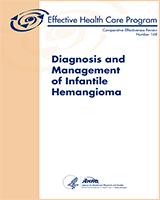Leaute-Labreze et al. 201592
G1: Propranolol, oral 3mg/kg/day for 6 months (102)
G2: Propranolol, oral 3mg/kg/day for 3 months (101)
G3: Propranolol, oral 1mg/kg/day for 6 months (103)
G4: Propranolol, oral 1mg/kg/day for 3 months (99)
G5: placebo (55)
Quality: Good | Age, days mean±SD
G1: 101.6 ± 31.0
G2: 107.5 ± 30.1
G3: 102.6 ± 30.1
G4: 103.6 ± 33.1
G5: 103.9 ± 31.1
Type, n (%)
Segmental
G1: 5 (5)
G2: 7 (7)
G3: 7 (7)
G4: 4 (4)
G5: 2 (4)
Localized
G1: 91 (90)
G2: 88 (88)
G3: 90 (88)
G4: 89 (91)
G5: 48 (87)
Indeterminate
G1: 5 (5)
G2: 5 (5)
G3: 5 (5)
G4: 5 (5)
G5: 5 (9) | G1+G2+G3+G4+G5: Multiple |
Serial photographs and clinical assessment by blinded investigators Nearly complete resolution defined as minimal degree of telangiectasis, erythema, skin thickening, soft-tissue swelling, and distortion of anatomic landmarks
| Complete or nearly complete resolution at 24 weeks, n (%)
G1: 61/101 (60%)
G5: 2/25 (4%)
p< 0.0001 | Need for additional treatment
|
Leaute-Labreze et al. 201399
G1: Propranolol, oral 3–4 mg/kg/day for 1 month (7)
G2: Placebo (7)
Quality: Fair | Age, weeks mean±SD
G1: 12.5 ± 2.1
G2: 12.4 ± 2.6
Type:
NR | G1+G2: multiple |
| Mean change in thickness, 5 [95% CI]
G1: −44.9% [36–76.2p
G2: +11.3%
G1 vs G2: p=0.004
Percentage change in size
G1: −15.8
G2: +8.9
G1 vs G2: p=0.041 |
|
Hogeling et al. 201117
G1: Propranolol oral, 2mg/kg/day in 3 daily doses (19)
G2: Placebo (20)
Quality: Good | Mean weeks, n
G1: 67
G2: 71
Type
Focal, n
G1: 16
G2: 17
Segmental
G1: 3
G2: 3 | G1+G2 multiple |
| Percent change in volume at 24 weeks
G1: −60% (n=18)
G2: −14.1% (n=15)
Difference between group −45.9 (95% CI: −80.3, −11.4) p=0.01 |
|
Sondhi et al. 201394
G1: Propranolol oral, 2mg/kg/day (31)
G2: No treatment, historical controls (14)
Quality: Fair | Age, mean months (range)
G1: 10.8 (1 mo–9 years)
G2: 8.6 (3–20 mo)
Type, n:
Superficial
G1: 11
G2: 6
Mixed
G1: 9
G2: 3
Deep
G1: 11
G2: 5 | G1+G2: multiple |
Photographs, color and size scored; degree of involution assessed by blinded investigators Change score: 0 considered completely normal skin, 10 no change in IH from pre-treatment
| Involution
Significant involution (> 50%), n (%)
G1: 28 (90.3)
G2: 4 (28.6)
Some involution (11%–50%), n (%)
G1: 0
G2: 2 (14.3)
No involution (≤ 10%), n (%)
G1: 3 (9.7)
G2: 6 (42.8)
Overall mean score
G1: 4.37 (95% CI: 3.15 to 5.59)
G2: 8.38 (95% CI: 7.71 to 9.01)
G1 vs.G2 p<0.0001 | Rebound growth
Predictors of response
100% of children ≤6 months old had complete response vs. 89% of children between 6–36 months old, and 0 children older than 36 months Greater magnitude of involution in children ≤6 months old Greater decline in heart rate after treatment initiation in responders vs. non-responders (p=.0006)
|
